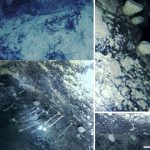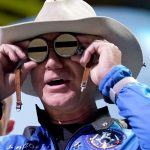Bones discovered on the Isle of Wight belong to two previously undiscovered species of large predatory dinosaur, according to scientists.
The bones were laid down over 125 million years ago during the Early Cretaceous period, before being unearthed on the beach near Brighstone over the past few years by fossil collectors and academics.
The dinosaurs the bones belonged to were closely related to the giant Spinosaurus and had unusual crocodile-like skulls that allowed them to hunt prey on land and in water.
Previously the only spinosaurid skeleton found in the UK belonged to the dinosaur Baryonyx, which was found in a quarry in Surrey in 1983, with the majority of other finds being limited to isolated teeth and single bones.
Researchers from the University of Southampton analysed the find and have confirmed that they belong to previously unknown species of dinosaurs, in a study published in the journal Scientific Reports.
Chris Barker, a PhD student from the University of Southampton and the study’s lead author, said: “We found the skulls to differ not only from Baryonyx, but also one another, suggesting the UK housed a greater diversity of spinosaurids than previously thought.
Co-author Darren Naish said that he’d been waiting for a Baronyx-like discovery on the Isle of Wight for a couple of decades, but that finding two in close succession was a “huge surprise”.
Liam Gallagher ‘fell out the helicopter’ after Isle Of Wight Festival and shares photo of scraped face
Social care facing ‘unprecedented crisis’ over staff shortages, say officials
UK festivals 2021: Why events such as Boomtown are cancelling – despite lockdown roadmap going to plan
The first has been named Ceratosuchops inferodios, which translates as the “horned crocodile-faced hell heron”.
This dinosaur has a series of low horns and bumps ornamenting its brow region, and “hell heron” refers to its likely hunting style, as herons catch aquatic prey around the margins of waterways but can also eat terrestrial prey.
The second was named Riparovenator milnerae, which translates as “Milner’s riverbank hunter”, in honour of the British palaeontologist Angela Milner who passed away this August and had named Baryonyx.
Please use Chrome browser for a more accessible video player
Dr David Hone, another co-author, from Queen Mary University of London, said: “It might sound odd to have two similar and closely related carnivores in an ecosystem, but this is actually very common for both dinosaurs and numerous living ecosystems.”
Although their skeletons are incomplete, the researchers estimate the dinosaurs measures around nine metres in length – one metre of which was taken up by their long skulls, which they used to snap up prey.
Dr Neil Gostling of the University of Southampton, who supervised the project, said: “This work has brought together universities, Dinosaur Isle museum and the public to reveal these amazing dinosaurs and the incredibly diverse ecology of the south coast of England 125 million years ago.”
Brian Foster, a fossil collector from Yorkshire who made an important contribution to the finds and the new study, said: “This is the rarest and most exciting find I’ve made in over 30 years of fossil collecting.”
Please use Chrome browser for a more accessible video player
Another collector who discovered several bones, and Isle of Wight resident, Jeremy Lockwood, said: “We realised after the two snouts were found that this would be something rare and unusual.
“Then it just got more and more amazing as several collectors found and donated other parts of this enormous jigsaw to the museum.”
Dr Martin Munt, the curator of the Dinosaur Isle Museum where the new finds will go on display, said they cemented the Isle of Wight’s status as one of the top locations for dinosaur remains in Europe and highlighted how collectors, academics and museums would work together on new finds.
Dr Munt added: “On behalf of the museum I wish to express our gratitude to the collectors, including colleagues at the museum, who have made these amazing finds, and made them available for scientific research. We also congratulate the team who have worked on these exciting finds and brought them to publication.”






















